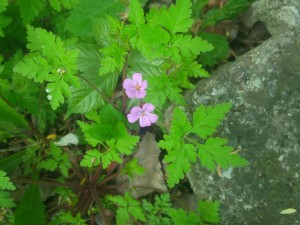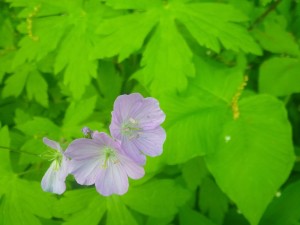
Late spring is geranium time—hardy geraniums or cranesbills, that is. A multitude of tough, low-growing perennials are currently flaunting their five-petaled blooms and lobed, dissected leaves in beds, borders and containers just about everywhere. While they will probably never eclipse the popularity of their flashy cousins, the pelargoniums, of front porch and window box fame, they have come into their own.
With all the available domesticated species and varieties, it is easy to overlook two appealing “wild” geraniums that are equally at home in country hedgerows and suburban flower beds. I am especially fond of two: the whimsically named “Herb Robert” and the unwhimsically named American or spotted geranium. Both are vigorous, floriferous and untroubled by most plant complaints. Deer and rabbits generally avoid them too, an added bonus to gardeners like me who have grown accustomed to living in the midst of a suburban wildlife sanctuary.
Depending on your sources and degree of credulity, Geranium robertianum, known commonly as Herb Robert, got its name from either an eleventh century monk or that legendary altruistic outlaw, Robin Hood. Herb Robert really doesn’t swashbuckle much, so I am drawn to the idea of monkish origins. The feast day of Saint Robert of Molesme, a French cleric and abbott renowned for his piety, falls in April, at around the time that Geranium robertianum begins blooming in some places.
Some sources list North America as one of Herb Robert’s native habitats, but it probably arrived here early from its home areas in Europe. It is also native to Eurasia and North Africa. Once it set up shop in North America, the little geranium moved into at least 23 states and four Canadian provinces. According to the Lady Bird Johnson Wildflower Center, Herb Robert is most comfortable in “ravines and rocky woodlands”. Other sources suggest that it also likes damp places. I have seen it emerging from a crack between pavers in partial shade.
The most noticeable features of Herb Robert are its half inch pink or pink-purple flowers, which appear on and off throughout the growing season. Fern-like foliage complements them. Examined closely, each leaf features five lobes, which are further dissected to give a feathery appearance. Allegedly the leaves exude an unpleasant odor when crushed, but I have never tried this.
Truly a low-grower, Geranium robertianum never reaches more than six inches in height, with a maximum spread of about eight inches. This makes it perfect for rock gardens and border edges. You might plant it around the edges of a large, mixed container.
Though it is technically an annual, Herb Robert might as well be perennial. Like other geraniums, it is notorious for spitting its seeds, which can land several feet from the mother plant. Herb Robert may not roam as much as Robin Hood, but it manages to be quite prolific for a sedentary being. Fortunately its offspring are very easy to grub out from places where they are not wanted.

Larger than Herb Robert, but equally appealing, spotted geranium shows up often on the edges of fields and woodlands. The one and a half-inch flowers are pink with just a hint of blue and bloom only once per growing season, usually in April or May. Flowers rise on dainty stems above palmate leaves, which form mounds on mature plants. A single spotted geranium might grow 18 inches tall, with a nearly equal spread.
Spotted geraniums have the same seed-spitting habit as Herb Robert and they are likely to naturalize in congenial settings. Unlike Herb Robert, spotted geranium is a true perennial, so you can also divide mature clumps to get even more plants. If you have a woodland garden, a native plant or pollinator landscape, or a semi-shaded bed that needs some mid-spring color, spotted geranium is for you.
Hybridizers have never had much interest in little Herb Robert, but spotted geranium is another story. A chocolate/purple-leafed variety, ‘Espresso’, provides excellent contrast to surrounding greenery. The white-flowered albiflorum form flourishes under the same conditions as the species. For color variation, try ‘Elizabeth Ann’, with blue-lavender blossoms and chocolate brown leaves.
Geranium maculatum is native to Eastern North America and has been used in herbal medicine by Native Americans and early settlers. Decoctions made from dried roots and leaves have been used as astringents, tonics and antiseptics.
While both Herb Robert and spotted geranium are great garden plants, neither works particularly well as a cut flower. Since both appear in spring, when an abundance of more suitable cut-flower sources pop out of the ground daily, this is not a major drawback.
Obtaining these useful geraniums may take a bit of doing. Geranium maculatum is available from Prairie Nursery, Inc., P.O. Box 306, Westfield, WI 53964; (800) 476-9453, www.prairienursery.com. Free catalog. Herb Robert is a little more difficult. Obtain seeds from Richter’s, Richter’s, 357 Highway 47, Goodwood, Ontario, L0C 1A0, Canada; 1-800-668-4372, www.richters.com.
